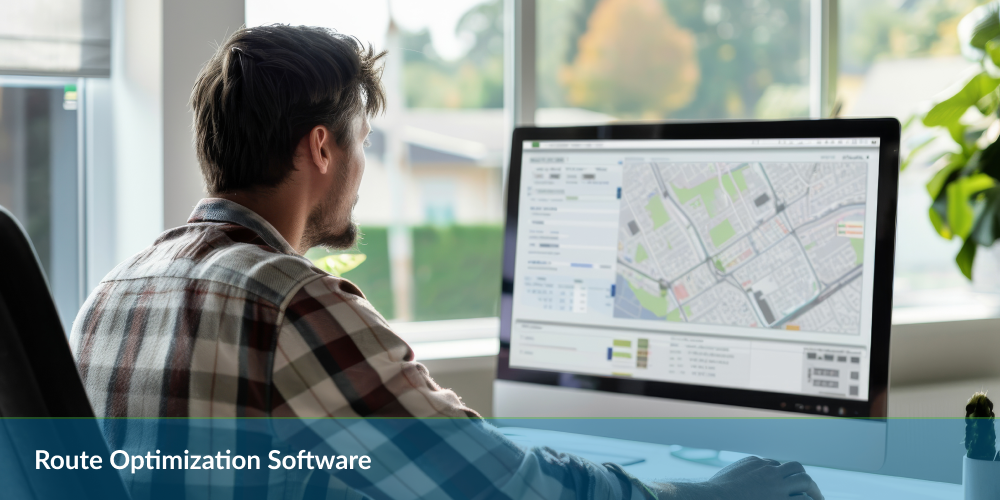Table of Contents
What if there was a tool that could simplify the intricate world of logistics and make it easier to navigate? This is exactly what route optimization software aims to achieve. By leveraging cutting-edge algorithms, it transforms a complex web of routes into a streamlined process, ensuring that every journey step is efficiently planned and executed.
Route optimization software considers multiple parameters to determine the best possible routes for vehicles. From traffic patterns and road conditions to vehicle capacity and delivery timeframes, the software analyzes all relevant data to craft a route that saves time and money. It’s a comprehensive tool that can significantly enhance operational efficiency.
Ultimately, route optimization software allows businesses to plan more effective and reliable logistics operations. By reducing unnecessary detours and improving route selection, companies can lower operational costs and enhance customer satisfaction through timely deliveries.
Evolutionary Milestones in Transportation
Embarking on a historical journey, the transportation sector has witnessed a pioneering shift with the advent of route optimization software. The origins trace back to the 1960s when the first computerized algorithms were developed to solve rudimentary routing problems. Today’s solutions, however, are marvels of precision, integrating real-time data and machine learning to adapt to ever-changing variables, marking a significant stride from the initial iterations. As transportation and delivery services burgeon, this technology stands as a bedrock in the industry, continually enhancing and simplifying the intricate mechanisms of route planning and logistics management.
Best Route Optimization Software
Route optimization software helps businesses streamline deliveries, reduce costs, and enhance efficiency by calculating the most efficient routes for drivers, saving time, fuel, and ensuring timely deliveries.
With a wide range of options available, choosing the best software for your specific needs can be challenging. Let’s explore the Top 5 Route Optimization Software known for enhancing routing efficiency, reducing delivery times, and offering valuable insights for businesses of all sizes and industries.
| Software | Key Features | Best For |
| NetworkON | Advanced route planning, real-time tracking, multi-stop optimization, analytics, custom integrations, automated alerts | Last-mile delivery, logistics, high-volume operations |
| Route4Me Route Planner | Automated route planning, real-time tracking, address validation, multi-vehicle support | Small to medium-sized businesses |
| Onfleet | Driver dispatch, route planning, real-time tracking, customer notifications | Delivery services, food & retail |
| Routific, Inc. | Route optimization, live tracking, fuel savings, driver efficiency tracking | SMBs and larger fleet operations |
| OptimoRoute Driver | Dynamic routing, scheduling, real-time updates, driver performance tracking | Field service businesses, logistics |
Role of Route Optimization in Fleet Management
Fleet management transforms with the integration of route optimization software, enabling companies to harness data for more informed decision-making. This technology reshapes several aspects of the logistics process, from asset utilization to maintenance schedules.
Improving Asset Utilization and Driver Management
Route optimization software enhances the productivity of both vehicles and drivers. By analyzing traffic patterns, delivery windows, and other critical data points, the software ensures that vehicles take the most efficient routes. This reduces idle time, increases the number of deliveries that can be performed, and enhances time management for drivers. Efficient route planning also minimizes the risk of driver fatigue, leading to safer operation.
Streamlining Planning and Scheduling for Deliveries
Delivery schedules become more reliable due to the predictive capabilities of route optimization. The software considers constraints such as delivery times and vehicle capacities to create optimal schedules. As a result, businesses can plan with precision, improving resource allocation and customer service. Planning complexity diminishes as the software automatically adjusts to new information, such as last-minute orders or cancellations.
Impact on Vehicle Maintenance Scheduling
Intelligent routing indirectly affects the longevity and performance of fleet vehicles by reducing the wear and tear associated with inefficient routes. Predictive maintenance schedules can be developed based on vehicle usage optimized to prevent unnecessary strain. This strategic approach to maintenance ensures that vehicles are serviced at the most appropriate times, extending their service life and reducing the likelihood of unexpected breakdowns.
- Optimized routes contribute to the even distribution of workloads across the fleet.
- Targeted vehicle maintenance leads to a decrease in downtime.
- Properly maintained vehicles are less likely to incur costly repairs or replacements.
Consequently, route optimization is a multi-faceted tool within fleet management that streamlines daily operations and provides a foundation for long-term strategic planning and cost management.
Pro Tip: Leverage route optimization software for efficient routes, enhance vehicle longevity, and reduce unexpected maintenance costs through predictive scheduling.
Enhancing Delivery Efficiency with Smart Planning
Route optimization tools are a cornerstone in streamlining delivery operations. By leveraging complex algorithms, these tools provide the most efficient routes, reducing travel time and fuel consumption. The direct outcome is a notable uptick in delivery speed and reliability.
Overcoming Last-Mile Delivery Challenges
Last-mile delivery is notorious for its complexity and cost, often constituting a significant portion of the total delivery cost. Route optimization software meticulously analyzes numerous variables like traffic patterns, delivery windows, and vehicle capacity constraints, offering viable solutions to these challenges. A solution that stands out is dynamic rerouting, allowing drivers to adjust their routes in real time to avoid delays and ensure timely deliveries.
With route optimization, businesses not only navigate operational hurdles but also pave the way for a swift and responsive delivery service network.
Navigating to Smarter Fleet Management with Real-Time GPS Tracking
The advent of Real-Time GPS tracking has revolutionized the way businesses manage their fleets. This technology provides live location updates, empowering fleet managers to make informed decisions with precision.
Explanation of Real-Time GPS Tracking
Real-time GPS tracking involves using satellites that communicate with devices fitted in vehicles to determine their exact locations continually. This data stream allows for monitoring vehicle movement, speed, and routes followed.
Integration with Route Planning
Embedding real-time GPS tracking within route optimization software creates a synergy that improves driver and delivery management. Route adjustments can be made on the fly to avoid delays caused by unexpected traffic conditions or changes in delivery schedules. Consequently, fleet managers are equipped to reroute drivers, reducing downtime and increasing overall efficiency.
Reduce Operational Costs through Route Optimization
Route optimization software is a multifaceted tool that is powerful in slicing operational expenses. Businesses witness a substantial dip in expenses by honing in on cost-saving factors like fuel consumption, time management, and vehicle maintenance. A granular look into these aspects clarifies the fiscal benefits.
| Cost Area | Impact of Route Optimization |
| Fuel Consumption | Reduced miles driven leads to significant fuel savings by minimizing unnecessary mileage. |
| Time Management | Faster delivery schedules reduce delays, turning saved time into a valuable asset for the business. |
| Maintenance Costs | Less road time results in fewer repairs and longer vehicle lifespans, reducing maintenance expenses. |
Fuel Consumption: The Nitty-Gritty of Savings
Navigating the intricate terrain of fuel savings, the software’s ability to concoct optimal routes cuts down on needless idling and rerouting. Fuel usage tails off not only due to shorter routes but also because vehicles can avoid traffic-heavy areas and optimize for speed and fuel efficiency. Companies take control of fuel budgets, diverting these savings to other pivotal areas.
Scaling Route Planning for Business Growth
Business expansion no longer signifies a proportional increase in routing complexities. Route optimization software adapts seamlessly, absorbing new information and scaling according to operational demands. When a business grows, the software scales accordingly, ensuring that routing efficiency and cost-effectiveness remain locked with operational expansion. This adaptive scalability ensures financial projections remain intact, irrespective of business size.
Tackling Traffic Congestion with Intelligent Routing
Dynamic routing adapts to changing road conditions, providing drivers with the most efficient paths to their destinations. By leveraging real-time traffic data, route optimization software promptly redirects drivers away from congested areas, thus reducing delays and improving overall travel times.
The infusion of real-time traffic data into routing systems offers a powerful advantage. Drivers receive updates on traffic conditions, accidents, and road closures, enabling informed decision-making en route and preventing unnecessary stoppages or delays.
Advanced algorithms and machine learning techniques underpin these sophisticated routing tools. Such technologies continuously analyze vast amounts of traffic data, drawing actionable insights that facilitate quicker and more efficient journey planning. Additionally, historical traffic data can predict peak congestion times, which the software uses to plan travel schedules that circumvent traffic-heavy periods.
Global Positioning System (GPS) technology, Geographic Information Systems (GIS), and real-time data analytics are pivotal in traffic congestion management. These technologies synergize within route optimization platforms, resulting in a robust approach to managing and alleviating traffic congestion for fleets of all sizes.
Pro Tip: Use real-time traffic data and AI-driven routing to avoid congestion, minimize delays, and optimize fleet efficiency.
Boosting Customer Satisfaction with Precise ETAs
Route optimization software enhances customer service by accurately predicting expected arrival time (ETA). By leveraging historical traffic data, current conditions, and machine learning algorithms, these systems accurately forecast arrival times. Customers appreciate knowing precisely when their deliveries will arrive, circumventing the uncertainty often accompanying service appointments and delivery windows.
Correlation Between Route Optimization and Improved Customer Service
When deliveries meet the predicted ETAs consistently, trust in the service provider grows. This trust translates into repeat business and positive word-of-mouth referrals. Furthermore, adherence to scheduled times allows businesses to handle service inquiries proactively, addressing any potential delays before they impact the customer experience.
The Role of Customer Feedback in Refining Routing Strategies
Responsive route optimization software can assimilate customer feedback to refine future routing. Understanding patterns in customer availability and preferences enables organizations to tailor delivery schedules, thereby reducing missed deliveries and increasing convenience for the recipient.
Sustainable Practices Through Optimized Routes
Environmental sustainability integrates seamlessly with route optimization initiatives. Organizations harnessing route optimization software significantly diminish their carbon footprint. Streamlined routes translate to fewer miles driven, directly decreasing fuel consumption and exhaust emissions. Reducing the vehicles required for transportation tasks further amplifies these environmental benefits.
Route optimization software facilitates adherence to stringent environmental standards. Companies can monitor and report their environmental performance effortlessly, ensuring compliance with regulations that mandate reductions in greenhouse gas emissions. These regulations often impose penalties for noncompliance, making the precision offered by route optimization solutions beneficial and necessary for businesses keen on maintaining their operational licenses.
- Advanced algorithms enable the calculation of the most efficient routes, considering factors beyond simple distance.
- Intelligent routing leads to less time on the road, curtailing fuel consumption and lowering greenhouse gas generation.
- Software analytics provide insights into travel patterns, identifying opportunities to combine deliveries or service calls.
Through these strategies, route optimization software positions companies at the forefront of ecological responsibility while bolstering their economic viability and community standing.
Mastering Route Optimization Software Selection
Selecting route optimization software necessitates a thorough understanding of your business’s unique requirements. Analyze your delivery operations to pinpoint areas where efficiency gains are most needed.
When choosing features, separate the essentials from the extras. Must-have features include dynamic routing, real-time tracking, and easy scalability as your business grows. Advanced analytics, on the other hand, can be useful but may not be necessary for every business.
Investigate various route planner options by initiating trials. Such evaluations allow for hands-on experience with the software’s interface and functionality. How the software handles real-time traffic conditions and changes in delivery variables will highlight its adaptability and robustness.
- Seek options that offer comprehensive reporting tools to measure the impact on operational efficiency.
- Assess the level of customer support provided; responsive support can be a deciding factor.
- Examine integration capabilities to ensure compatibility with existing systems and technologies.
- Explore user reviews and case studies for additional insight into the software’s performance in similar business scenarios.
Pro Tip: Choose software that integrates seamlessly with your system, allows customization, and scales with your business growth.
Key Takeaways:
- Route optimization software reduces fuel consumption, and maintenance costs, and improves time management, leading to significant operational savings.
- The software calculates the most efficient routes, speeding up deliveries, reducing travel time, and ensuring more reliable service, thus enhancing customer satisfaction.
- Integrating route optimization with real-time GPS tracking improves asset utilization, driver management, and vehicle maintenance, making fleet operations more efficient.
- Streamlined delivery routes reduce fuel usage and carbon emissions, contributing to environmentally friendly operations and helping businesses meet regulatory standards.
- As businesses grow, route optimization software scales seamlessly, maintaining efficiency and cost-effectiveness even as operational demands increase.
Wrapping It Up!
Route optimization software stands at the forefront of transforming the transportation and logistics industry. With its sophisticated algorithms, the software significantly enhances delivery efficiency and cost-effectiveness. Companies witness substantial mileage reduction while benefiting from the automation of complex routing decisions.
As transportation dynamics evolve, route optimization technologies are advancing in lockstep. They are becoming more predictive, adapting to road conditions in real-time, and facilitating sustainable operations that align with regulatory demands. These developments promise to fine-tune logistics operations further, promising a competitive edge to those who leverage them.
With the advent of big data, AI, and machine learning, the potential of route optimization is expanding, allowing for intricate analysis of patterns that contribute to even smarter routing solutions. In navigating the future, businesses will increasingly rely on such tools to stay agile and responsive to market changes.
Transform your logistics with NetworkON’s Route Optimization Software!
Experience the future of transportation efficiency—reduce mileage, automate routing, and stay ahead of the competition. Sign up for a demo or contact us for a personalized consultation to explore how our cutting-edge solutions can optimize your operations.
Frequently Asked Questions
What is route optimization software, and how does it work?
Route optimization software uses advanced algorithms to analyze traffic patterns, road conditions, and vehicle capacity to determine the most efficient delivery routes. It helps reduce fuel costs, improve delivery times, and enhance operational efficiency.
How can route optimization software improve customer satisfaction?
Route optimization software ensures timely deliveries by providing accurate, real-time delivery updates and predicting precise ETAs. This builds trust, reduces customer uncertainty, and enhances the overall customer experience, leading to higher satisfaction and loyalty.
Can route optimization software handle last-mile delivery challenges?
Yes, route optimization software is specifically designed to tackle last-mile delivery complexities. It uses dynamic rerouting based on real-time data to avoid traffic, optimize routes, and ensure timely deliveries, even during unexpected delays.
Is route optimization software scalable for growing businesses?
Absolutely. Route optimization software can scale with your business needs, adapting to larger fleets, new delivery areas, and increasing operational demands. It ensures continued efficiency and cost-effectiveness as your business expands.





0 Conversations